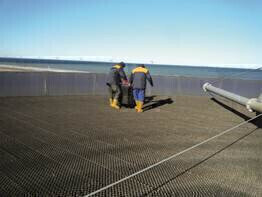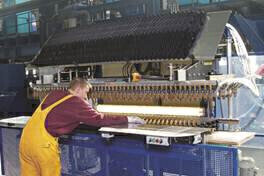-
 You can walk on GEA 2H PP fill media.
You can walk on GEA 2H PP fill media. -
 Welding of PP fill media
Welding of PP fill media
Water/Wastewater
Trickling Filter Media: Polypropylene makes the Difference
Jul 10 2014
GEA Heat Exchangers (Germany) will present the advantages of trickling filter media made of Polypropylene compared to PVC at stand 2939 at WEFTEC 2014 in New Orleans, the leading trade fair for water and wastewater technology in the US.
During recent decades, trickling filter media made of polypropylene have gained growing acceptance throughout the world. PP media implement valuable features that make them attractive substitutes for commonly used PVC fills.
Plastic trickling filter media are effectively used in biological wastewater technology because they provide a large surface for biofilm. This biofilm consists of active microorganisms that break down organic pollution present in wastewater (e.g., BOD, N, etc.). The trickling filter process itself is a simple but efficient technology: wastewater is evenly distributed onto a large media stack through which it trickles. The biofilm then cleans the water.
However, optimal trickling filter design and operation are essential for effective treatment success.
Requirements for fill media are manifold. First, they should provide a large surface for the biofilm to grow. In addition, sufficient air circulation is necessary to provide the required oxygen. The biofilm should also demonstrate appropriate thickness, and the water should flow through slowly and evenly. The resulting total configuration makes up a balanced three-phase system in which water, air, and biosolids share the void space within the fill media. Such systems represent a challenge for the design engineer. With BIOdek fills, GEA Heat Exchangers provides a selection of media types to effectively accommodate many of these process requirements, any type of flow pattern, and a variety of channel sizes to optimise each trickling filter application.
There are other requirements in addition to those involving the process itself. The media must be self-supporting and sufficiently rigid to withstand the weight of the biofilm and of any captured water. It must retain its shape for a lifetime of decades and must be disposable in an environmentally friendly way. Hydrocarbons such as PP can be easily recycled.
The properties of the materials used can be summarised as follows: PP is not as stiff as PVC. Due to the elasticity of PP, a man can walk on the top layer of the trickling filter for inspection without damaging the structure. PVC filters, on the other hand, need a walking grate on top: made of PP.
PP is of less density than PVC; hence PP sheets are much thicker than PVC sheets of identical weight. This property provides greater resistance against erosion and media buckling, which is the most common cause of failure reason when a filter collapses.
GEA BIOdek PP media is thermo-welded, which represents a major advantage in the production process. The use of thermo-welding technology means that GEA Heat Exchangers protects its employees and the environment from hundreds of tons of solvents otherwise released into the atmosphere. Solvent gluing is the common bonding technology for PVC media.
Owing to these and other advantages, the share of PP media on the market has increased, and GEA expects ongoing development of PP products as substitutes for PVC. GEA Heat Exchangers still offers a PVC product line, but customers usually do not return to PVC once they have used PP products – which confirms the trend toward PP.
From September 27 to October 1, 2014, at a fair stand shared with GEA Westfalia Separators, GEA Heat Exchangers will present lamella separators and fill media for treatment of potable water and wastewater.
Events
Apr 22 2024 Hannover, Germany
Apr 23 2024 Kuala Lumpur, Malaysia
Apr 24 2024 Sao Paulo, Brasil
May 05 2024 Seville, Spain
May 13 2024 Munich, Germany












